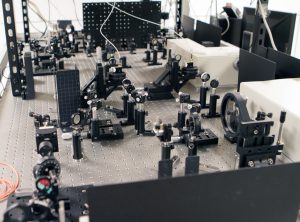
Chunqiang Li, Ph.D., assistant professor of physics at The University of Texas at El Paso, has received a $650,000 grant from the National Science Foundation to develop advanced optical microscopic technology for molecular and cellular imaging.
“I share Dr. Li’s joy for his tremendous accomplishment of securing this grant in a highly competitive national environment,” said Vice President of Research Roberto Osegueda, Ph.D.
Li’s microscope will revolve around two significant innovations: high speed and the ability to capture motion in three dimensions.
“We’re living in a three-dimensional world, but optical microscopes only capture one plane at a time, creating flat images,” the physicist said, referring to standard optical microscopes that capture cells and their movement in two dimensions: side-to-side, and up and down. “There is a big demand for imaging that can capture all three dimensions.”
Additional imaging techniques are able to capture the third dimension – depth – but the process is extremely tedious. Current procedures include gradually “depth scanning” an object, which involves placing the object on a movable stand that can move close to and away from the lens. This allows the focus of the camera to steadily change, capturing the various depths and angles of the object. The 3-D object is then recreated, pixel by pixel, on the screen.
Using new physics concepts, Li will bypass the slower scanning process and speed up how quickly the images are created. At the same time, with the help of co-principal investigator Wei Qian, Ph.D., professor of electrical and computer engineering, the technology will track molecular and cellular motion, automatically generating high-speed, 3-D videos of the fast microscopic processes taking place.
To verify the equipment works and has wide applicability, co-principal investigators Kyung-An Han, Ph.D., associate professor of biological sciences; Jorge Gardea-Torresdey, Ph.D., professor and chair of chemistry; and Chuan Xiao, Ph.D., assistant professor of chemistry, will use the microscope for their own studies on neurotransmitters, nanoparticles and marine viruses.
“The beauty of this project is that it’s interdisciplinary,” Han said. “With the outside expertise of biologists and chemists – some of the people who will use and benefit from this technology – Li will be able to build a practical device.”